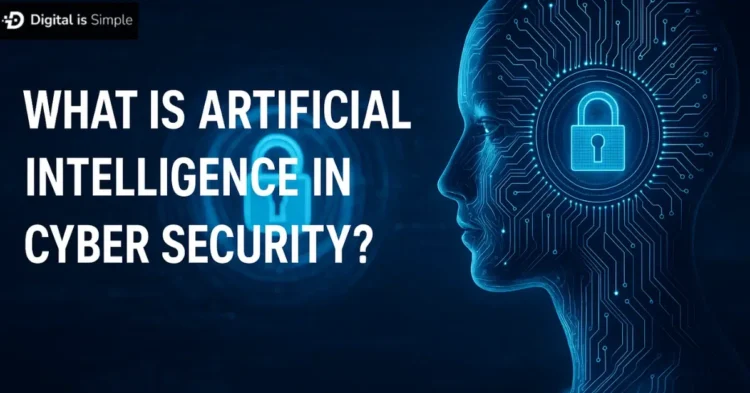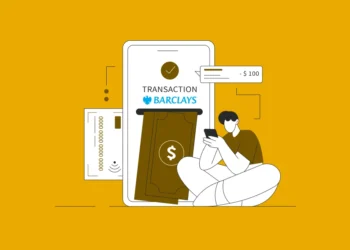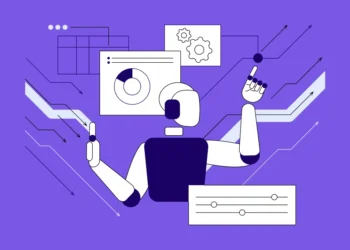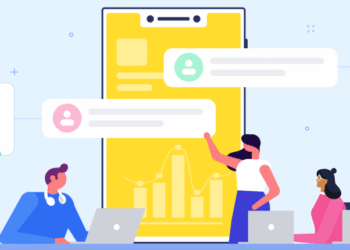You don’t need me to tell you that the digital world has changed.
Attackers aren’t bored teenagers in a basement anymore. They’re organized, funded, and faster than ever. And the old playbook of firewalls and passwords isn’t enough.
Enter Artificial Intelligence in Cybersecurity, but as a new operating system for defense. Think of it as the difference between a night guard with a flashlight and a drone with thermal vision. Same job. Different league.
Let’s break it down.
The Shift: When AI Meets Cybersecurity
Traditional cybersecurity is reactive. It used to rely on databases of “known” viruses. When a virus gets spotted → signatures are updated → patch deployed. By then, the damage is often already done.
Through AI agent development, businesses can create intelligent, autonomous agents that continuously monitor networks and respond faster than human analysts ever could.
But AI doesn’t wait. It learns. It hunts. It predicts.
- Instead of just checking against a known threat database, AI models look at behavior.
- A login from another city at an odd time that looks nothing like an employee’s pattern? Flagged.
- A massive data upload to an unknown server? Blocked instantly.
Where humans see logs, AI sees stories. It connects dots at machine speed—dots no human analyst could process in time.
That’s the shift: from chasing threats to staying three steps ahead.
Role of artificial intelligence in Cybersecurity
Because business problems don’t start with technology. They start with risk.
- Downtime costs money. A ransomware attack can freeze operations for days.
- Breaches kill trust. Customers don’t forgive companies that leak their data.
- Scale breaks humans. Your team can’t manually sift through millions of alerts every day.
Artificial Intelligence in Cybersecurity attacks those exact pain points.
- It cuts through noise and shows what actually matters.
- It automates response in seconds, not hours.
- It reduces dependency on human reaction time.
Well, there is no more stress as AI transforms cybersecurity from a bottleneck into a growth accelerator.
Benefits of Artificial Intelligence in Cybersecurity

- AI in cybersecurity gives you speed. The kind of speed at which attacks are stopped before you even know they started. AI cuts the detection threat to seconds that could have taken weeks otherwise. What if your bank’s AI flagged a massive data transfer at 2 AM, but AI shut it down before hackers could touch customer records.
- It gives you focus. No more drowning in alerts that don’t matter. So, no more false positives, ML models filter noise that reduces the false positives. Imagine this: instead of your security team chasing 10,000 red flags, AI narrows it to 30 that actually matters.
- It saves money—not just by cutting costs, but by saving the brand from a PR disaster preventing breaches to avoid regulatory fines. If there is a ransomware attack but AI can neutralize it instantly. Skip fines and no PR disaster. You can carry on business uninterrupted.
- And most importantly, it gives you trust. Because your customers don’t want apologies after a breach. They want confidence before one. Proactive security translates into brand credibility.
- And businesses are even leveraging AI-powered chatbots for growth by using these intelligent systems to improve customer interactions, reduce downtime, and enhance operational efficiency.
In short, AI doesn’t just protect your business—it powers it, turning security into a strategic advantage.
Use of Artificial Intelligence in Cybersecurity
What if your system could stay one step ahead by learning from every new threat automatically? With every failed login and every unusual data access, it evolves its defenses continuously. That’s not just a vision — it’s happening today.
- Firewalls: AI watches traffic, spots anomalies in real-time, and adapts on the go—no static rules needed.
- Email gateways: AI scans every email, and it scans for content, metadata, and sender behavior—AI blocks phishing before it reaches an inbox.
- SIEMs that predict: Thousands of logs, endless alerts—AI filters the noise and highlights only what truly matters.
- MDR platforms: Threats don’t wait, and neither does AI—it isolates endpoints, blocks malicious activity, and stops breaches before humans even log in.
Not Just Detecting—AI in MDR Predicts and Prevents
Managed Detection and Response (MDR) is all about finding threats early and stopping them fast. MDR is the proof of AI in action. With AI, it predicts. It sees behavior before it turns into a breach, and acts before the damage spreads.
But here’s the challenge: MDR generates mountains of data—endpoints, cloud traffic, user behavior, network logs. Human analysts drown in alerts.
AI doesn’t drown.
- No time is wasted chasing the false positives. Instead of 10000 alerts, analysts only see those 50 that really matter. It’s because of Classifiers and behavioral baselines, AI distinguishes what is a real threat and what isn’t.
- It prioritizes risks—deciding what needs immediate action. Its risk-scoring algorithms and contextual enrichment (like asset criticality, attack vectors, or user privileges), AI ranks threats by severity.
- It responds—isolating endpoints, killing malicious processes, or blocking suspicious IPs—often before a human has even read the alert. It’s possible with the use of automated playbooks in SOAR (Security Orchestration, Automation, and Response) systems, AI executes containment actions in seconds.
The result? MDR goes from firefighting to foresight.
Types of AI Threats You Need to Know
Here’s the catch: AI is a double-edged sword. Attackers use it, too.
The most serious AI-powered threats that you need to watch out for:
- Deepfake Phishing: Synthetic voices or videos tricking employees into transferring money or data.
- AI-Powered Malware: Malware that learns and evolves to avoid detection.
- Adversarial Attacks: Feeding false data into AI models to confuse them.
- Automated Exploits: Bots that scan and exploit vulnerabilities faster than humans can patch.
The irony? The same tech that protects can also attack. Which is why businesses need AI on their side first.
Application of AI in Cybersecurity To Protect Businesses

Beyond traditional detection tools, modern cybersecurity is starting to leverage conversational AI platform to interact with employees, answer security queries, and provide instant guidance during suspicious activities.
Let’s make this less abstract. Here’s how AI is protecting and solving business problems:
-
Phishing Detection
Email content, metadata all this is AI scans and blocks suspicious messages, even the most sophisticated ones that slip past spam filters.
-
Insider Threats
Let’s say that if an employee suddenly downloads thousands of files at midnight, AI monitors user behavior, it doesn’t wait approval but instead it locks access instantly.
-
Cloud Security
AI spots anomalies in cloud traffic, like unusual API calls or data movement between regions, before attackers exploit them. Thus, it flags anything that strays from normal patterns.
-
Fraud Prevention
Banks use AI to track transaction patterns. If a credit card is suddenly used in two countries within an hour, AI freezes it before fraudsters get far.
The Best AI Tool for Cybersecurity
Everywhere you look, there are plenty of platforms that promise AI wonders. But if you ask security leaders, Darktrace consistently stands out.
It’s built on what they call the “Enterprise Immune System.” Instead of relying solely on signatures, it learns the unique “DNA” of your network and flags deviations instantly.
Of course, tools like CrowdStrike Falcon and IBM QRadar also leverage AI brilliantly. The point isn’t the brand—it’s the capability. The right AI tool adapts to your environment, not the other way around.
Here are some more:
Vectra AI – Focuses on network detection and response, spotting hidden threats using behavior analysis.
CylancePROTECT – Predicts and prevents malware execution using AI-driven threat modeling.
How Can Artificial Intelligence Be Used in Cybersecurity?
Let’s connect the dots:
- Threat Detection: Spotting zero-days, phishing, insider risks.
- Response Automation: Isolating machines, blocking IPs, reconfiguring firewalls.
- Risk Scoring: Ranking vulnerabilities by potential business impact.
- Continuous Learning: Models evolve with every attack attempt, getting smarter over time.
AI doesn’t replace your cybersecurity team. It amplifies them. It handles the heavy lifting, so humans focus on strategy, empathy, and judgement.
The Bottom Line
Cybersecurity used to be about building higher walls. Today, it’s about building smarter guards.
Artificial Intelligence development services are not a luxury—it’s the baseline for doing business in a world where threats evolve faster than any human can keep up with.
The companies that adopt AI don’t just defend it better—they build trust, protect revenue, and sleep easier at night.
Because the future of cybersecurity isn’t human or AI. It’s both—working in tandem, at scale, with speed.
FAQs
-
What is a Conversational AI Platform and how is it used in cybersecurity?
Conversational AI Platform lets machines chat naturally with humans. In security, it can guide employees, answer questions, and flag issues instantly.
2. How can AI-powered chatbots help businesses grow?
By leveraging AI-powered chatbots for growth, companies can improve customer engagement, automate responses, and even support security processes—all at once.
3. Are Conversational AI Platforms safe to use in sensitive environments?
Yes! Modern platforms come with encryption and strict access controls, keeping sensitive data secure while still enabling real-time guidance.
4. Can leveraging AI-powered chatbots for growth reduce operational costs?
Definitely. They handle routine tasks and security alerts, freeing up your team and saving time and money.


















